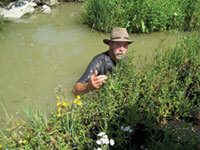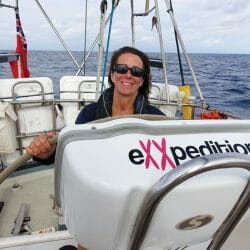Bruce Kania ’75: Floating a Sustainable Idea

Bruce Kania ’75 installs an aerator under a floating island at the Shepherd (Montana) Research Center
No man is an island. However, one man’s name is becoming synonymous with them. Bruce Kania ’75came up with the idea for Floating Island International after seeing firsthand how our wetlands and waterways are being destroyed.
In 2000, his dog, Rufus, jumped into a pond and came out coated in a reddish goop. The water was teeming with nitrogen and phosphorus, runoff from nearby farms and ranches — the same kind of runoff that pollutes waterways around the world.
Concerned for the future of the environment, Kania remembered the floating peat bogs that surrounded him as a fishing guide growing up in northern Wisconsin.
These floating wetlands are among nature’s most productive ecosystems. So Kania brought together a team of engineers, scientists, and plant specialists, and set out to “biomimic” the wetlands — duplicating nature’s processes in a sustainable and efficient way.
What they came up with was a matrix made of post-consumer materials (recycled plastic bottles) that they used to create islands capable of supporting the weight of plants and soil. In fact, the recycled fibers within the matrix proved to be excellent material for growing biofilm, while still allowing water to pass through it — the key features of a wetland. This allowed unwanted nutrients to be “eaten” by bacteria forming on the island and in the plant roots. These man-made islands also offer another positive outcome by keeping millions of plastic bottles out of landfills.
“We opened our doors in 2005, and today we’ve got four thousand islands in the water,” says Kania. These islands — designed to clean polluted water, spur the growth of fish, provide species habitats, and sequester carbon — have been launched in the United States, Canada, Australia, New Zealand, Singapore, Korea, and Europe. And their largest island to date spans 39,800 square feet.
According to Kania, four or five other companies produce floating wetlands, but his is the only one that biomimics naturally occurring floating islands. “[Ours] have other unique characteristics that differentiate them from anybody else’s, in that they can actually grow terrestrial plants and can support many tens of thousands of tons of negative buoyancy,” he says. (Negative buoyancy is everything above the water line.)
Floating Island International doesn’t manufacture the islands; they develop prototypes and license them to businesses that are better positioned to take the islands into the marketplace. “I run a think tank oriented around the concept of floating wetlands and their impact on water-quality enhancement,” says Kania.
That sharing of ideas is what initially drew him to UW–Madison. “It’s almost like an urban think tank,” he says. “Madison is in a very environmentally rich, verdant location … where the woodlands meet the prairie, and folks [such as] Aldo Leopold and others have such a legacy of working around environmental issues. It can’t help but permeate you when you’re there.”
Published in the Fall 2011 issue



Comments
Beth Zupec-Kania October 4, 2011
This guy is a genious. I love that he has invented something that will proliferate wildlife above and below the water and restore health to water supplies. YOu can even grow vegetable gardens on these islands. GO BRUCE!
Verna Lundin April 3, 2012
We live in a co-op complex and have two waste water ponds that turn green in the summer. Your system sounds like the perfect answer. Could you give me an estimate of the cost involved? I would like to present this to our long term planning committee Verna
Nandkishore November 3, 2012
An excellent effort towards sustainability. Congrats Bruce!